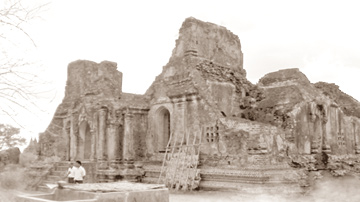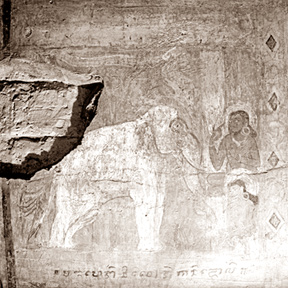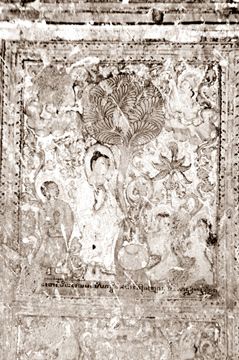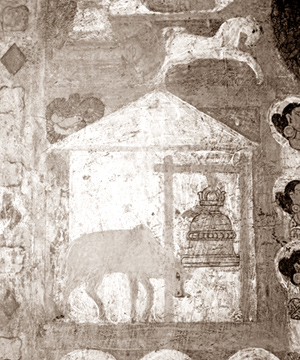Revisiting Sri Lanka-Myanmar historical links
Dr. Hema GOONATILAKE
The intense relationship between Sri Lanka and Myanmar spans over a
period of 1,000 years beginning with the emergence of Bagan as the
cradle of Burmese culture and civilization in the 11th Century.
 |
|
Shwezigon
Temple |
This ancient capital of Myanmar epitomizes one of the world's
greatest feats of building construction - greater than all of Europe's
cathedrals, the construction of which spread over nearly seven centuries
whereas Bagan is home to 4,446 monuments, built within a period of less
than two and a half centuries, mostly within a period of 150 years.
Bagan is a unique city encompassing approximately 40 square km. with a
wide variety of religious buildings, some standing higher than 70 metres.
Twelfth Century murals depicting scenes from the chronicle Mahavamsa,
four abodes of Sinhala monks and 260 large monuments influenced by
Sinhalese are some of the re-discoveries that I have been able to make
during my study visits to Bagan in the recent years.
Bagan to the Myanmar people is what Anuradhapura is to Sri Lankans -
especially Sinhala Buddhists. Sri Lanka's contribution towards the
consolidation of the Bagan Empire in terms of religion, culture and
civilization is attested to in the Myanmar historical chronicles,
inscriptions, art and architecture, as well as in Sinhalese records.
What Sri Lanka later gained from Myanmar is equally significant.
Myanmar's religious gifts to Sri Lanka - the Amarapura and the Ramanna
sects contributed a great deal to the religious, cultural and
educational renaissance in the 18th and 19th Centuries, the influence of
which continues to this day.
Famous relics
Sri Lanka being not only the foremost centre of Buddhism, but also
the country that possessed two of the most famous relics of the Buddha,
the sacred Tooth Relic and the Alms Bowl, attracted the rulers of
Southeast Asia. It appears from Myanmar historical chronicles that the
highest ambition of Bagan kings was to possess the sacred Tooth relic of
the Buddha. King Anawrahta sent a mission to Sri Lanka along with a gift
of a white elephant to obtain the sacred Tooth Relic from his friend
Vijayabahu I (1055-1110 A.C.). (This event is not mentioned in Sri
Lankan sources).
Anawrahta received only a replica of the Tooth Relic. The King made a
vow for it to replicate and there emerged four other replicas. He
enshrined the first in the Shwezigon Stupa which he built in 1059 A.C.
The other four were enshrined in four other Stupas, the most famous
among them being Lawkananda. Situated on the riverbank, Lawkananda is an
ancient landmark near the old harbour where vessels from Sri Lanka,
Arakan (Rakhine) and the Mon Ramannadesa anchored.
Mahavamsa paintings
Among the most interesting sights in Bagan for Sri Lankans is the
Mahavamsa episodes painted in the Myinkaba Kubyauk-gyi Temple in Bagan.
This Temple has pictorial illustrations of a large number of episodes
covering the history of Buddhism in Sri Lanka up to the reign of our
King Vijayabahu, the contemporary of King Anawrahta and Kyanzittha. The
murals relate events from Asoka's life including his paying homage to
Moggaliputta Tissa Thera. There is also a sequence of panels depicting
the first three Buddhist Councils.
 |
 |
| Sri Lanka
Monastery |
Elephant
Kandula |
The scenes in these pictorial illustrations include: the Buddha's
visits to Sri Lanka, Emperor Asoka and King Devanampiyatissa, Asoka's
message and the gifts for Devanampiyatissa's coronation,
Devanampiyatissa's meeting with Thera Mahinda and Theri Sanghamitta's
arrival in Sri Lanka carrying the Bodhi tree. On another wall are the
scenes from the life of the Mahavamsa hero, Dutthagamini, namely: his
elephant Kandula, he being given the name Abhaya (fearless), Abhaya
wanting to go out and fight the enemy, when his father forbids him, he
sends his father a woman's dress making the father angry, King Elara and
the number of villages he administers and his justice bell which is rung
by a cow when his son drives his chariot over a calf.
Another Mahavamsa inspired set of paintings are found in the
Sakyamuni Temple where scenes from Sanghamitta's arrival in Sri Lanka
are depicted. Sakyamuni Temple, also built in the 12th Century has
scenes of Theri Sanghamitta bringing the Bo sapling to Sri Lanka and the
Bo plant becoming one thousand times bigger after pouring of water on
it.
These stories are known to every child in Sri Lanka. It seems to be
the same in Myanmar too. The late historian Dr. Godakumbura mentions
that on a visit to Myanmar in the 1960s, he found to his amazement that
the Myanmar people considered Sri Lanka history to be their history and
Dutthagamini, the national of Sri Lanka, specially of Sinhala Buddhists
as their national hero. The Bhikkuni Suwimalee who as child stayed in
Myanmar in the 1950s as her father was the Sri Lanka ambassador to then
Myanmar confirms this. She remembers that the maid who looked after her
in Yangon used to say that Dutu Gamunu was their hero. A somewhat
similar view is held in the whole of South-East Asia. (I have seen
during several years' stay in Cambodia similar recollections among the
Cambodian people of Sri Lanka history, especially the Dutu Gemunu
episode.) One of the explanations given by Western historians of the
mural depictions of wars in that region as occurring between kings
fighting on elephants is that the original model was the Dutu
Gemunu-Elara battle on elephants It should be remembered that Myanmar
historical writings themselves began under the guidance of Sinhala
Bhikkhus. The Myanmar chronicles such as the Mahasammatavamsa, Rajavamsa
and Sasanavamsa were directly modeled after the Mahavamsa.
Sri Lankan Monks' Monastery Complexes
Illustrating the general prestige of Sinhalese monks, a Myanmar
inscription dated 1268 A.C, claimed that the deeds of merit by the donor
were witnessed by all the Sri Lankan monks. An inscription near the
Sinhalese style Stupa (No. 1113) in the vicinity of the Tamani complex
of monasteries dated 1271 A.C recorded by Tissa Maha Thera is
indicative. It describes the mission undertaken by a Bagan monk to Sri
Lanka carrying a message from the King of Bagan to the Sri Lankan King
requesting for more Sri Lankan monk teachers to go to Myanmar to
propagate the Buddha's message.
During the reign of King Narapatisithu and the period immediately
thereafter, several large monastery complexes that were built in Bagan
were dedicated to Sinhalese monks. Inscriptions and ruins of several
monasteries belonging to this period demonstrate that a large number of
influential Sri Lankan monks taught Myanmar monks and Samaneras.
The monasteries where the Sri Lankan monks resided are located South
of the old city. The monks from Sri Lanka came to be known also as the
Tamani group or sect and the monasteries that they resided in were known
as Tamani monasteries. The largest monastery complex identified as
Tamani comprises three large monasteries, located near each other. I
have visited them a few times and let me give a brief description.
 |
 |
|
Sanghamitta carrying Bo Sapling |
King
Elara’s Bell and Cow |
One large monastery has two floors while a broken Buddha image still
lies among the ruins of the monastery which accommodated around 100
monks.
An inscription dated 1277 A.C. inside this monastery refers to
Venerable Tamalin (a Sinhalese monk), the head of a large monastery who
was supported by Queen Summula's daughter Princess Acau and her uncle
Singasu. Tamalin was one of the most popular monks during the reign of
King Tarukpliy of the 13th Century, also known as Narathihapate.
One of the three monasteries was specially allocated to the Samaneras.
Numerous were the Stupas built according to the Sinhalese bell-shaped
style. There were at least 260 such Sri Lankan style Stupas. The inflow
of Sinhala Buddhist culture was facilitated by Myanmar monks going to
Sri Lanka and Sri Lankan monks coming to Bagan.
The Stupa built by Chapata who received Upasampada and studied in Sri
Lanka for ten years is one of these Stupas built according to the Sri
Lanka style.
Marriage alliances
There have been also marriage alliances between our two countries.
According to Myanmar historical chronicles, King Alaungsithu of the 12th
Century, King of Myanmar (who was a contemporary of Parakramabahu the
Great) visited Sri Lanka.
Alaungsithu, married a daughter of the Sinhalese king and returned
with an image of Maha Kassapa Thera who was highly venerated at the time
in Sri Lanka. (It was Maha Kassapa Thera who helped reform our Sasana
under Parakramabahu). Although not mentioned in Sri Lankan records,
there is evidence from Myanmar inscriptions that confirms the strong
Sinhalese connection with the Myanmar royalty during that time. The
premier historian of Myanmar, Gordon Luce and local historians have
given evidence to show that there was a strong Sinhalese influence in
the Bagan Royal Court during the reigns of Alaungsithu and Narapatisithu.
Wife of King Narapatisithu, Queen Uchokpan was a Sinhalese princess,
possibly the daughter of Parakramabahu I.
Lankan monks
Uchokpan had come to Bagan with her brother who was appointed as a
Minister of the King. She was made the favoured, though not the chief
Queen of Narapatisithu, as evident from the title she had. Queen
Uchokpan's two sons, Rajasura and Gangasura, though precluded from
succession, remained for a long time influential figures at the Court,
loyal to Narapatisithu and his successors.
Queen Uchokpan's nephew was a strong supporter of Sri Lankan monks
who established the 'Sihala Sangha' there.
But the political relations were sometimes antagonistic. The
Culavamsa records that the Myanmar King caught sight of a letter
addressed to the King of Cambodia in the hands of the Sinhalese envoys
and suspecting that they were envoys sent to Cambodia (there was also a
Sinhalese princess among them, possibly sent as a bride to a Cambodian
prince), seized them and punished them.
He also immediately stopped Sri Lanka's lucrative elephant trade with
foreign countries and captured the elephants, money and vessels of
Sinhalese envoys. Later the conflict was resolved and warm relations
were re-established with the intervention of monks of the two countries.
The relationship has been mutually beneficial for both countries on
many fronts. It is a good foundation to strengthen the friendship
between the two countries.
With the rise of Asia as the centre of economic, political and
cultural focus in the world, we can together make Buddhism again the
unifying force in Asia as well as across the new globalised world at a
time when Buddhism is being widely spread in the Western world. |



